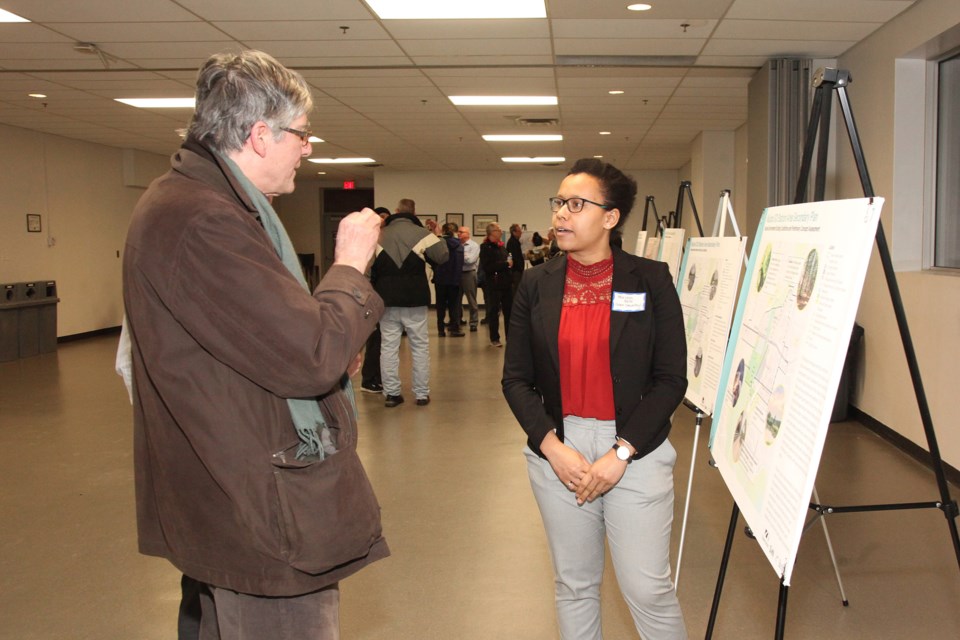It’s unclear whether or when Newmarket residents will see a new GO station at Mulock Drive and Bayview Avenue, but one thing is certain: the town is well on its way in reimagining the area into a pedestrian friendly and transit-supportive community.
Residents last Tuesday had an opportunity to learn more about and provide their feedback on what’s known as the Mulock GO station area secondary plan study, which will serve as a blueprint to guide growth and future development of the largely commercial and industrial area.
Town planners are about halfway through the study process, and a draft of the planning document is expected to come before council for approval in September 2019.
The development of the Mulock corridor, which includes lands east along Bayview, west to Cane Parkway on the north side of Mulock, and an area on the south side of Mulock, excludes the proposed site for the GO station itself at the intersection of the railway line and Mulock Drive.
That’s because while the Mulock GO station, and others in the GTHA, got the go-ahead by the former Ontario Liberals and transit-planning authority Metrolinx, the incoming Ford government put the brakes on the stations in November 2018 in favour of a market-driven approach that would court private-sector investment instead.
The town’s secondary plan stands on its own and, once approved, could be used as a marketing tool to attract development and investment along the Mulock corridor, said town senior planner Adrian Cammaert.
“We’re identified as a GO station site, and we’ll have an approved planning document that regulates land uses in a transit-oriented manner,” Cammaert added. “This allows us to go to the development industry and say, ‘This is a great site to come develop and invest in’.”
The lands pegged for development in the secondary plan could include such things as parks and open spaces, trails, restaurants and small businesses, housing and even new streets, all designed to attract people and jobs that would support transit ridership.
“People are generally supportive of the notion that the area is due for a bit of a rethink from a planning standpoint,” Cammaert said. “One of the things we heard from the public is to make sure to account for various modes of transportation, such as people on foot and cyclists, and not just vehicles, and make sure there is access to and from the trail network near the site. All these things are considered.”
The Mulock corridor area was developed around the rail line in the early 1980s and it played a functional role in servicing the town’s industrial end, Cammaert added.
“But now that’s not the case anymore,” he said. “Does it still make sense to have those industrial employment uses there? We’re not sure, so that’s why we’ve come up with the study.”
Residents also expressed concerns and an interest in potential traffic problems that could arise as a result of train service in the area, parking, increased population, the development’s impact on the rest of the town, and the environmental footprint on the neighbouring Bailey Ecological Park, a bird and animal sanctuary.
Resident Gordon Prentice, who runs a local political blog, raised the issue of grade separation to help combat potential gridlock from the temporary halting of traffic flow to allow GO trains to cross major roads in Newmarket.
The idea of grade separation usually refers to a tunnel, bridge or pathway to separate rail traffic from vehicular and pedestrian traffic. In the case of the Mulock GO station, that responsibility would fall to the Regional Municipality of York and Metrolinx, not the town, officials say.
In one of the earlier Mulock GO station designs presented by Metrolinx, the agency decided not to proceed with grade separation for the Mulock and Bayview location.
“Grade separation is an interesting area, and it does alleviate traffic concerns but it can present issues in urban design,” Cammaert said. “It might not attract the kind of investment that’s beneficial to the area. You don’t have to have grade separation to accommodate a station or have 15-minute train service, that can happen separately.”
For more information on the Mulock GO station area secondary plan study, visit here.
To add your feedback, visit the Town of Newmarket’s Hey Newmarket blog.
The town is looking for your feedback on the following:
- Existing parks and open spaces and where you might like to see new parks and open spaces
- Existing trails and connections and where you might like to see new trails and connections
- Existing street networks and where you might like to see new streets
- Existing buildings and where you might like to see different land uses (e.g. new residential uses, new commercial uses) and buildings (e.g. taller buildings, lower buildings)
~With files from Greg King

